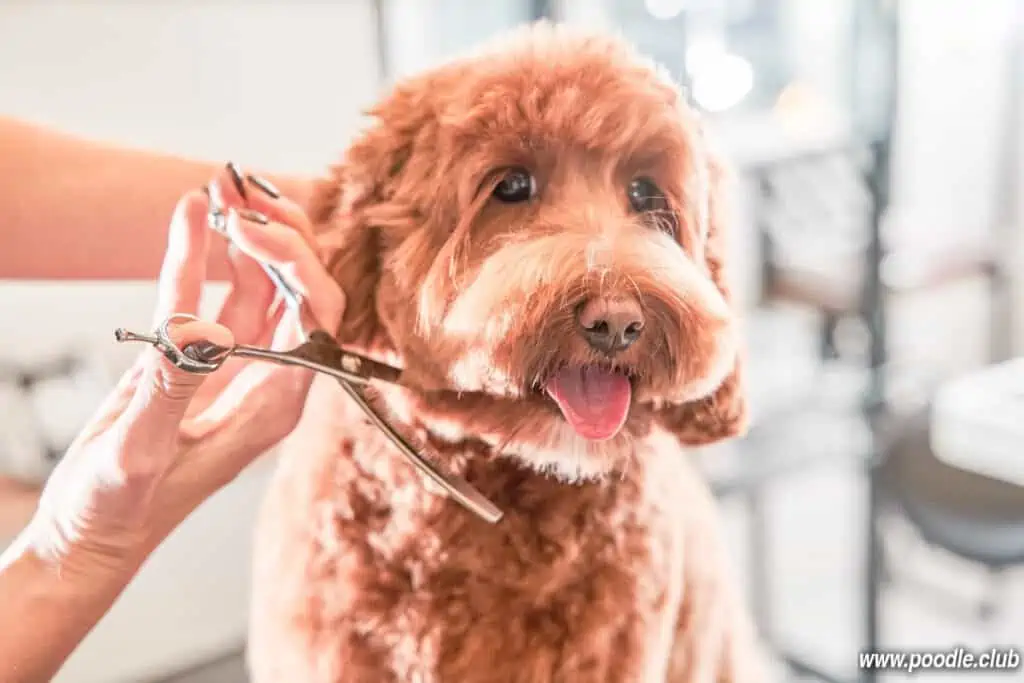How to Choose the Best Labradoodle from a Litter? [Expert Tips]
Choosing the best Labradoodle from a litter can be an exciting yet challenging task for potential dog owners. As a mix between a Labrador Retriever and a Poodle, Labradoodles are known for their friendly nature, intelligence, and low-shedding coats. With each puppy in the litter possessing unique physical traits, temperaments, and health predispositions, it’s essential to know what to look for to find the perfect fit for your family and lifestyle.
First, it’s crucial to familiarize yourself with the Labradoodle breed, as this knowledge will guide you in identifying desirable traits. By understanding more about your future pup’s behavior and possible health concerns, you can make an informed decision while picking the perfect puppy from the litter. Analyzing temperament, assessing physical health, and considering maintenance needs are key factors that will help you make your choice.

Key Takeaways
- Familiarize yourself with Labradoodle temperament and physical traits.
- Assess the health and genetics of puppies in a litter.
- Choose a reputable breeder and consider maintenance needs.
Understanding Labradoodles
When considering a Labradoodle as your new family member, it’s essential to learn about the breed’s history and characteristics. Labradoodles are a popular hybrid dog breed, resulting from crossing a Labrador Retriever with a Poodle. Known for their intelligence, friendly nature, and low-shedding coats, they have become a popular choice for many families.

The origin of Labradoodles dates back to the 1980s when an Australian breeder, Wally Conron, intentionally bred a Labrador and a Poodle for the first time to create a hypoallergenic guide dog. The result was a breed that combines the best traits of the parent breeds: the intelligence and trainability of the Poodle and the friendly, affectionate nature of the Labrador.
As a hybrid breed, Labradoodles can vary in appearance and temperament, depending on the traits inherited from their parent breeds. There are two primary types of Labradoodles: the Australian Labradoodle, which usually has a mix of Labrador, Poodle, and other breeds like the English and American Cocker Spaniel, and the traditional Labradoodle, which is a direct cross between a Labrador and a Poodle.
Labradoodles come in various sizes, depending on the size of the Poodle parent. They can be:
- Standard: 50-65 pounds, 21-24 inches tall
- Medium: 30-45 pounds, 17-20 inches tall
- Miniature: 15-25 pounds, 14-16 inches tall
It’s worth noting that Labradoodles, like Goldendoodles, are not considered purebred by the American Kennel Club. However, this hasn’t hurt their popularity among families and dog enthusiasts.
When selecting a Labradoodle from a litter, pay close attention to the individual puppy’s temperament, energy level, and appearance. Look for a healthy, active puppy who shows a friendly disposition, as these traits tend to make for a great, well-rounded family pet. By understanding the unique history and characteristics of Labradoodles, you’ll be better equipped to choose the perfect puppy for your family.
Identifying Physical Traits
When choosing the best Labradoodle from a litter, it’s important to examine various physical traits. One key factor to consider is size. Labradoodles come in three sizes: standard, medium, and miniature. Observe the litter and try to determine which puppies fall into your preferred size category.

Keep in mind, their size as adults will generally be relative to their size as puppies.
PuppySpot is a reputable dog marketplace where you can browse and find compatible puppies right from the comfort of your home. They have placed over 200,000 puppies into homes in the US!
Next, take a good look at the coat of each puppy. Labradoodles are known for their diverse coat types, which can be curly, wavy, or straight. You’ll want to focus on coats that are non-shedding or hypoallergenic, especially if you have allergies.
Gently touch and lift their ears to check for any signs of infection or irritation.
Labradoodle coat colors can vary greatly. Some common colors include:
- Black
- Blue
- Brown
- Red
- Cream
- Gold
- Apricot
- Caramel
- Chocolate
Pay attention to each puppy’s coat color, as different colors may have unique characteristics. Observe if any puppies have unique markings or patterns that stand out to you.
Evaluating the eyes of each puppy is crucial. Healthy eyes should be clear and bright, without discharge or redness. A puppy with good eye contact is a good indication of strong mental and emotional development.
Examine the puppies’ body structure and shape. A well-proportioned Labradoodle will have a solid, sturdy body. Specific weight and height may vary depending on the size category, but a balanced appearance is key.
By carefully assessing each puppy’s physical traits, including size, coat type and color, eyes, and body structure, you’ll be able to make a more informed decision when selecting the best Labradoodle from the litter.
Deciphering Health and Genetics
When choosing a Labradoodle puppy from a litter, it’s crucial to consider their health and genetic background. By doing so, you’ll ensure your new companion has the best chance at a healthy and happy life.

Firstly, research the litter’s lineage, specifically their parents and grandparents. This will provide you with an understanding of their potential health issues and genetic traits. Two prevalent health problems in Labradoodles are hip and elbow dysplasia.
Checking their generations, from F1 to the multigenerational F3, can give insight into the prevalence of these issues.
For further confidence in your choice, request health testing documentation from the breeder. This will help verify the absence of any significant health problems. A responsible breeder should be happy to provide such information.
To better understand Labradoodle generations, consider the following terms:
- F1: A cross between a purebred Labrador Retriever and a purebred Poodle.
- F1B: The offspring of an F1 Labradoodle and a purebred Poodle.
- F2: The offspring of two F1 Labradoodles.
- F2B: The offspring of an F1 Labradoodle and an F1B Labradoodle.
- F3: The offspring of two F2 Labradoodles or higher-generation Labradoodles.
Each generation carries its unique genetic traits, such as coat type, personality, and health concerns. Keep these factors in mind when evaluating your options.
In conclusion, thoroughly researching health and genetics will enable you to make an informed decision when choosing the best Labradoodle puppy from a litter. Always prioritize health and ethical breeding practices to ensure your future fur friend has the best chance at a happy and healthy life.
Analysing Temperament and Personality
When choosing the best Labradoodle from a litter, it’s essential to analyze the temperament and personality of each pup. To do this, spend time observing and interacting with each puppy individually.

Since Labradoodles are known for their friendly, active, and intelligent nature, look for a pup that displays these characteristics. A well-rounded Labradoodle should be sociable and eager to play, showcasing its playful demeanor. Observe how the puppy interacts with its littermates and with you, as this can give you valuable insight into its personality.
Intelligence is another important factor to consider. A smart Labradoodle will be easy to train and highly trainable. Look for a pup that displays curiosity, as well as the ability to learn quickly.
Introduce basic commands or tasks, and assess how the puppy responds to them.
Temperament is essential for any dog, but especially for a hypoallergenic breed like the Labradoodle. A calm demeanor can make a Labradoodle a better fit for individuals with allergies. Look for signs of a calm disposition, such as a puppy that doesn’t get overly excited or agitated during playtime.
While assessing the personality of your potential Labradoodle, also take note of their loyalty. A loyal pup will form a strong bond with you early on and exhibit signs of separation anxiety when you’re away. Keep this in mind when interacting with the puppy, and observe how they respond when you leave the room or come back in.
Remember, finding the perfect Labradoodle is all about looking for a pup with a friendly, active, and intelligent nature. With the right temperament and personality, your Labradoodle will be a loyal, easy-to-train, and sociable companion for years to come.
Considering Breeders
When looking for the best Labradoodle from a litter, it’s important to consider the breeder. Reputable breeders are crucial in ensuring that you are adopting a healthy and well-adjusted puppy. They will have extensive knowledge about Labradoodles, making it easier for you to find the right companion.

To find reputable Labradoodle breeders, start by doing thorough research. Some points to keep in mind are:
- Experience: Breeders with years of experience will have a better understanding of the breed and its characteristics.
- Health screening: Good breeders will provide health screenings and genetic testing for both parents and puppies.
- Transparent communication: A reputable breeder will answer your questions honestly and provide you with valuable insights about their Labradoodles.
- Facility: Inspect the breeder’s facilities to make sure they are clean and well-maintained, ensuring that the puppies are raised in a healthy environment.
- References: Gather feedback from other people who have adopted from the breeder and inquire about their experiences.
In addition to finding a reputable breeder, it’s worth considering adoption. There are many Labradoodles in need of loving homes. Adopting from a rescue organization is a great way to give a deserving dog a second chance at happiness.
Factoring in Maintenance and Care
When choosing the best Labradoodle from a litter, it’s essential to consider the maintenance and care associated with owning one of these lovely dogs. This includes understanding the costs, exercise requirements, grooming, shedding, and interaction with family members and other pets.

Labradoodles have various coat types, which can affect the amount of grooming they require. Their coats can range from wavy to curly, and each type has its own level of shedding. Generally, Labradoodles are low-shedding dogs, making them an excellent choice for families with allergies.
However, keep in mind that grooming needs can still vary. To maintain a healthy coat and minimize shedding, regular grooming (brushing and trimming) is necessary.
Exercise and playtime are crucial for a Labradoodle’s mental and physical health. These dogs love to run, play fetch, and socialize with other dogs. Ensure that you can commit to providing daily exercise and playtime to keep your Labradoodle happy and healthy.
A well-exercised dog also tends to be more relaxed and well-behaved around the home.
Labradoodles typically interact well with children and other pets, making them a popular choice for family pets. When selecting your puppy, observe how it interacts with its littermates and the breeder’s family. It’s essential to choose a puppy with a temperament that fits well with your family dynamics.
When it comes to costs, expect to invest both time and money in your Labradoodle. The initial price of a Labradoodle can vary, but they can sometimes be on the higher end due to their popularity and demand. Besides the initial price, consider ongoing costs like food, grooming, vaccinations, and routine vet check-ups.
In conclusion, factoring in maintenance and care is an essential step in choosing the best Labradoodle from a litter. When you understand the requirements and costs involved, you’ll be better equipped to select a suitable family pet that will bring joy to your household for years to come.






![What Cream Can I Put on My Dog’s Sore Bum? [Soothe Pain]](https://poodle.club/wp-content/uploads/2023/03/what-cream-can-i-put-on-my-dogs-sore-bum-768x512.webp)
![Why Is My Dog Sleeping With Its Tongue Out? [Is it OK?]](https://poodle.club/wp-content/uploads/2023/01/dog-sleeping-with-tongue-out-pc-768x512.webp)